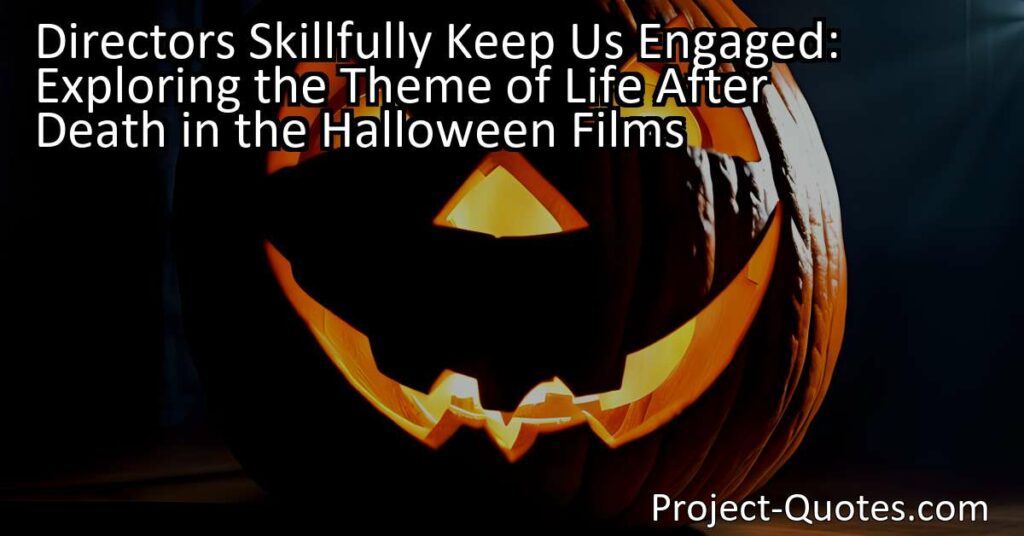The idea of dying and coming back is what makes the Halloween films work.
Donald Pleasence
The directors of the Halloween films skillfully keep us engaged by exploring the theme of life after death. Through the resurrection of the notorious killer Michael Myers and the suspenseful plot twists surrounding his character, the films add layers of intrigue and suspense that captivate audiences. By blurring the lines between life and death and tapping into our universal fascination with the mysteries of mortality, the directors skillfully maintain our interest and investment in the storylines.
Table of Contents
Meaning of Quote – The idea of dying and coming back is what makes the Halloween films work.
Halloween films have captivated audiences for decades, and one of the key elements that keeps us coming back for more is the concept of death and resurrection. British actor Donald Pleasence, who portrayed the iconic character Dr. Samuel Loomis in the Halloween franchise, recognized the significance of this idea in making these films successful in the horror genre. Through the resurrection of the infamous masked killer Michael Myers and the various plot twists surrounding his character, this theme of life after death adds layers of intrigue and suspense to the Halloween films.
In the world of horror, death has always been an integral part of storytelling. It invokes fear, uncertainty, and a sense of vulnerability within us. However, what sets Halloween apart from other horror franchises is its exploration of the supernatural and the ominous possibility of coming back from the dead. Pleasence’s insight sheds light on why this concept has resonated with fans for generations and continues to be a driving force behind the enduring popularity of the Halloween series.
Death, as a theme, has fascinated humanity since the dawn of time. In many cultures, death is seen as a transition to another realm or existence. From ancient myths to religious beliefs, people have always been intrigued by what lies beyond the veil of mortality. The Halloween films tap into this universal fascination by blurring the lines between life and death, prompting us to question the nature of our own mortality.
Throughout the Halloween franchise, the character of Michael Myers embodies this concept of death and resurrection. He is portrayed as an almost supernatural force, surviving seemingly fatal injuries and always rising up again to continue his merciless killing spree. It is this constant resurrection that instills a chilling sense of dread in both the characters within the films and the audience watching. We are left wondering if Michael Myers is truly immortal or if there is something more sinister at play.
Furthermore, the idea of dying and coming back also creates a sense of mystery within the Halloween films. As audiences, we are both repulsed and fascinated by the mystical nature of death. We are drawn to the enigma of what happens during the transition between life and death and the potential consequences it may have. By entwining this theme into the Halloween films, the writers and directors skillfully keep us engaged and invested in the storylines.
Donald Pleasence’s portrayal of Dr. Samuel Loomis complements the idea of dying and coming back in the Halloween films. As Michael Myers’ psychiatrist, Loomis is the one who understands the gravity of the situation and the evil that lies within the masked killer. He repeatedly warns others of the danger and tries to prevent Michael from causing more harm. Loomis’ character adds depth to the theme of resurrection by highlighting the psychological impact on a person who has witnessed such relentless evil firsthand.
In addition to the suspense and mystery, the concept of dying and coming back also serves as a powerful metaphor for the human condition. It symbolizes our innate fear of mortality and the eternal struggle between good and evil. Just as Michael Myers keeps returning, we are reminded that evil is often persistent and relentless. The Halloween films offer a glimpse into this dark aspect of humanity, forcing us to confront our own fears and question the boundaries of life and death.
The recurring theme of resurrection also allows the Halloween franchise to explore the concept of redemption. Can a person who has fallen into darkness find a way back to the light? By presenting characters who are entangled in the web of Michael Myers’ violent legacy, the films raise this moral dilemma. Some characters succumb to their darkest instincts, while others fight to overcome the evil that threatens to consume them. This struggle between redemption and damnation adds emotional depth to the Halloween films, making them more than just simple slasher movies.
In conclusion, Donald Pleasence’s observation that the idea of dying and coming back is what makes the Halloween films work is both insightful and accurate. The exploration of life after death, the blurred lines between the living and the dead, and the theme of resurrection all contribute to the success and enduring popularity of this beloved horror franchise. By tapping into our universal fascination with death and its mysteries, the Halloween films invite us to confront our own mortality and contemplate the forces that lie beyond this earthly existence.
I hope this quote inspired image brings you hope and peace. Share it with someone who needs it today!


